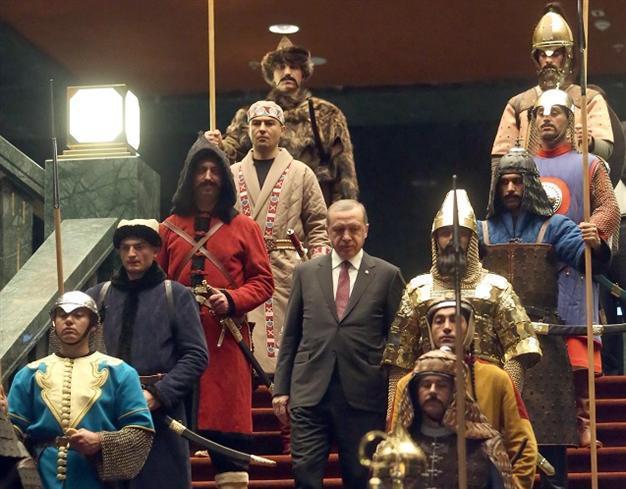COMMENT: What’s the meaning of Erdoğan’s 16 warriors?
Emre KIZILKAYA - ekizilkaya@hurriyet.com.tr
 Turkish President Recep Tayyip Erdoğan undertakes his own myth-making project, as seen in the controversial dress show of the 16 warriors in the presidential palace. His goals, however, seem like they will be more difficult to attain than similar projects by Atatürk several decades ago.
Turkish President Recep Tayyip Erdoğan undertakes his own myth-making project, as seen in the controversial dress show of the 16 warriors in the presidential palace. His goals, however, seem like they will be more difficult to attain than similar projects by Atatürk several decades ago.Turkish social media went into overdrive on Jan. 12 after President Erdoğan welcomed Palestinian counterpart Mahmoud Abbas in the presidential palace with actors dressed in knightly attire, ostensibly representing the military costumes of the 16 states founded throughout history by Turks.
Some social media users slammed the show as “ridiculous,” while others defended it as a historical panorama of “our forefathers.”
The presidential guards command headquarters had reportedly suggested the show during the term of Abdullah Gül, but his successor, Erdoğan, become the first president to agree to stage it.
Some claimed that Erdoğan put up the dress show to manipulate the news agenda in his favor, or merely to stay on the radar of the national and international media. After all, he has made several headline-making statements in the past months.
Clearly, Erdoğan plans and acts to show that he still rules the country, as well as the government and the ruling party that he left behind – on paper.
Before Erdoğan’s election, the office of the president was a largely ceremonial post. Since his election as president in August 2014, the number of Erdoğan’s statements and public appearances increased, while his tone has become even harsher and ... more interesting.
Although it is true that the military dress show functioned as yet another way of keeping Erdoğan in the headlines while underlining the new role of the presidency in the so-called “New Turkey,” it might have more overarching meanings.
New narratives for ambitious visions
After moving out of the presidential mansion of Atatürk to a gargantuan complex that he ordered built, Erdoğan has apparently started to build myth-making narratives that fit his political and historical vision, just like modern Turkey’s founder once did.
Cutting ties with certain state traditions, after all, requires a new set of traditions to be invented or “rediscovered.” If some ceremonial military uniforms feature “funny” elements like bearskin caps in Europe, why wouldn’t Turkish officials find something from Turkish history?
Nothing would look farcical with such a vision in mind, but there are still problems from an objective point of view.
Atatürk’s nationalist myth-making overwhelmingly succeeded in the building of the Turkish nation-state in the 1920s and the 1930s. Although scientifically problematic on several areas (cf. the Sun Language Theory that claims Turkish was the forefather of all the languages in the world), Atatürk’s myth-making projects on many other levels were well-conceived and carefully built at a time when international conditions were also ripe for them.
Erdoğan’s first “myth,” on the other hand, was frowned upon and even mocked by many people, not just because the military dress show looked farcical due to its rather shoddy implementation. The Islamist/imperialist theory that it is trying to build is also awfully outdated on a global scale.
Problems arise
First of all, the narrative that said the 16 stars on the Presidential Seal represent the 16 great Turkish states in the history was proposed by an army captain only in 1969. Even the presidency’s official website still lists this rendition as only one of the theories about what the stars could represent.
Secondly, many historians suggest that some of “the Turkish states” were actually neither Turkish nor states. Finding inspiration in a confederation of steppe nomads that collapsed 1,500 years ago may seem irrelevant, not glorious, to many who live as a citizen of a modern democracy in the age of globalism.
Leaving the performance to one side, the political theory behind the military dress show is equally weak, particularly in today’s world.
The Ottoman soldier “imperialistically” represents the longest-living empire among the “12 stars” in front of Abbas, who ironically represents Palestine, which was ruled by the Ottoman Turks for over three centuries.
The show created an awkward patron-client situation vis-à-vis Abbas himself, which contradicts Turkish foreign policy’s actual goals. Meanwhile, and maybe more importantly, the Ottoman soldiers’ historical reference to an “ummah” is outdated, considering the pulse of the street in the Muslim world, which has recently been throbbing with more nationalist sentiments than religious ones, particularly since the Arab Spring turned into an autumn.
Daily politics vs. long-lasting ideology
Politics, after all, is a specter, just like seen in the military dress show at the presidential palace. Political theory, on the other hand, requires a deep, intellectual labor.
That is why we see that Turkish Islamism has so far produced great politicians like Erdoğan, and his teacher Necmettin Erbakan, who managed to mobilize masses, but failed to produce any remarkable Islamist ideologues, like Sayyid Qutb in Egypt or Ali Shariati in Iran. As such, the stage that Abbas found himself in Ankara was perfectly political, but also ultimately transient due to a lack of coherent theory behind it.
Shrugging off such criticism, Erdoğan will almost surely continue trying to invent traditions for the New Turkey’s ideological myth-making. However, unlike those by Atatürk, these attempts are more likely to fail given the present conditions in Turkey and the world, as well as the poorly conceived and badly performed nature of President Erdoğan’s first ventures in myth-making.
As such, the show of “Erdoğan’s 16 warriors” might only have a legacy as lasting as that of the steppe nomads.
* Emre Kızılkaya is the managing editor of Hürriyet Daily News. The views expressed are his own.
















